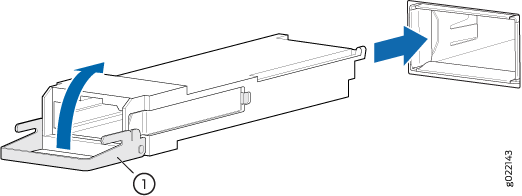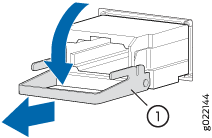Maintain the PTX10001-36MR Transceivers and Fiber-Optic Cables
The transceivers for the PTX10001-36MR router are hot-removable and hot-insertable field-replaceable units (FRUs). You can remove and replace them without powering off the device or disrupting device functions.
To understand how to install or remove a transceiver of a PTX10001-36MR router, read the following sections.
Remove a QSFP28 or QSFP56-DD Transceiver
28-Gbps quad small form-factor pluggable (QSFP28) transceivers and double density quad small-form factor pluggable (QSFP56-DD) transceivers can be removed from the device. Transceivers are hot-insertable and hot-removable. Removing a transceiver does not interrupt the device functioning, but the removed transceiver no longer receives or transmits data.

To remove a QSFP28 or QSFP56-DD transceiver (see Figure 1):
Install a QSFP28 or QSFP56-DD Transceiver
To install a replacement QSFP28 or QSFP56-DD transceiver:
Remove a Transceiver
Before you remove a transceiver from a device, ensure that you have taken the necessary precautions for the safe handling of lasers (see Laser and LED Safety Guidelines and Warnings).
Ensure that you have the following parts and tools available:
-
An antistatic bag or an antistatic mat
-
Rubber safety caps to cover the transceiver and fiber-optic cable connector
-
A dust cover to cover the port or a replacement transceiver
After you remove a transceiver, or when you change the media-type configuration, wait for 6 seconds for the interface to display the operational commands.
Figure 2 shows how to remove an SFP+ or QSFP+ transceiver.
To remove a transceiver from a device:
Install a Transceiver
Before you install a transceiver in a device, ensure that you have taken the necessary precautions for safe handling of lasers (see Laser and LED Safety Guidelines and Warnings).
Ensure that you have a rubber safety cap available to cover the transceiver.
After you insert a transceiver or after you change the media-type configuration, wait for 6 seconds for the interface to display operational commands.
We recommend that you use only optical transceivers and optical connectors purchased from Juniper Networks with your Juniper Networks device.
The Juniper Networks Technical Assistance Center (JTAC) provides complete support for Juniper-supplied optical modules and cables. However, JTAC does not provide support for third-party optical modules and cables that are not qualified or supplied by Juniper Networks. If you face a problem running a Juniper device that uses third-party optical modules or cables, JTAC may help you diagnose host-related issues if the observed issue is not, in the opinion of JTAC, related to the use of the third-party optical modules or cables. Your JTAC engineer will likely request that you check the third-party optical module or cable and, if required, replace it with an equivalent Juniper-qualified component.
Use of third-party optical modules with high-power consumption (for example, coherent ZR or ZR+) can potentially cause thermal damage to or reduce the lifespan of the host equipment. Any damage to the host equipment due to the use of third-party optical modules or cables is the users’ responsibility. Juniper Networks will accept no liability for any damage caused due to such use.
Figure 3 shows how to install a SFP+ or QSFP+ transceiver.
To install a transceiver:
To prevent electrostatic discharge (ESD) damage to the transceiver, do not touch the connector pins at the end of the transceiver.

1 — Ejector lever |
Disconnect a Fiber-Optic Cable from the PTX10001-36MR
Before you disconnect a fiber-optic cable from a PTX10001-36MR, ensure that you have taken the necessary precautions for safe handling of lasers (see Radiation from Open Port Apertures Warning and Laser and LED Safety Guidelines and Warnings).
Ensure that you have the following parts and tools available:
Rubber safety cap to cover the transceiver
Rubber safety cap to cover the fiber-optic cable connector
The PTX10001-36MR has optical transceivers to which you can connect fiber-optic cables.
To disconnect a fiber-optic cable from an optical transceiver installed in the PTX10001-36MR:
Connect a Fiber-Optic Cable to the PTX10001-36MR
Before you connect a fiber-optic cable to a PTX10001-36MR, ensure that you have taken the necessary precautions for safe handling of lasers (see Radiation from Open Port Apertures Warning and Laser and LED Safety Guidelines and Warnings).
The PTX10001-36MR has optical transceivers to which you can connect fiber-optic cables.
To connect a fiber-optic cable to an optical transceiver installed in the PTX10001-36MR:
Do not look directly into a fiber-optic transceiver or into the ends of fiber-optic cables. Fiber-optic transceivers and fiber-optic cables connected to transceivers emit laser light that can damage your eyes.
Do not stare into the laser beam or view it directly with optical instruments even if the interface has been disabled.
Maintain Fiber-Optic Cables in the PTX10001-36MR
To maintain fiber-optic cables in a PTX10001-36MR:
When you unplug fiber-optic cables from transceivers, place rubber safety caps over the transceivers and on the end of the cables.
Anchor fiber-optic cables to avoid stress on the connectors. When attaching a fiber-optic cable to a transceiver, be sure to secure the fiber-optic cable so that it does not support its own weight as it hangs to the floor. Never let a fiber-optic cable hang free from the connector.
Do not bend fiber-optic cables beyond their minimum bend radius. Bending the cables beyond their minimum bend radius can damage the cables and cause problems that are difficult to diagnose.
Frequent plugging and unplugging of fiber-optic cables in and out of optical instruments can damage the instruments, which are expensive to repair. Attach a short fiber extension to the optical equipment. Any wear and tear due to frequent plugging and unplugging is then absorbed by the short fiber extension, which is easier and less expensive to replace than the instruments.
Keep fiber-optic cable connections clean. Microdeposits of oil and dust in the canal of the transceiver or cable connector can cause loss of light, reduction in signal power, and possibly intermittent problems with the optical connection.
To clean the transceiver canal, use an appropriate fiber-cleaning device such as RIFOCS Fiber Optic Adaptor Cleaning Wands (part number 946). Follow the directions in the cleaning kit you use.
After cleaning the transceiver, make sure that the connector tip of the fiber-optic cable is clean. Use only an approved alcohol-free fiber-optic cable cleaning kit such as the Cletop-S® Fiber Cleaner. Follow the directions in the cleaning kit you use.

